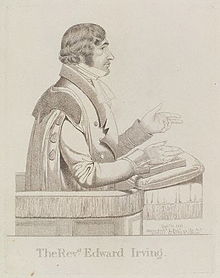Edward Irving
Edward Irving (4 August 1792 – 7 December 1834) was a Scottish clergyman, generally regarded as the main figure behind the foundation of the Catholic Apostolic Church.
; and in 1810, on the recommendation of Sir John Leslie, he was chosen master of the mathematical school, newly established at Haddington, East Lothian.
[1] (Confusingly, Irving was also influential in the life of another Scottish Thomas Carlyle, born a few years later, whom he eventually gave a position of some responsibility within his new church.
Completing his divinity studies by a series of partial sessions, he was licensed to preach in June 1815, but continued to discharge his scholastic duties for three years.
He devoted his leisure, not only to mathematical and physical science, but to a course of reading in English literature, his bias towards the antique in sentiment and style being strengthened by a perusal of the older classics, among whom Richard Hooker was his favourite author.
At the same time his love of the marvellous found gratification in the wonders of the Arabian Nights, and it is further related of him that he used to carry in his waistcoat pocket a miniature copy of Ossian, passages from which he frequently recited with sonorous elocution and vehement gesticulation.
Chalmers himself, with no partiality for its bravuras and flourishes, compared it to Italian music, appreciated only by connoisseurs; but as a missionary among the poorer classes he wielded a powerful influence.
[1] With a sudden leap into popularity, he was compared to the eloquence made in the House of Commons by George Canning, who had been induced to attend his church from admiration of an expression in one of his prayers, quoted to him by Sir James Mackintosh.
"His commanding stature, the symmetry of his form, the dark and melancholy beauty of his countenance, rather rendered piquant than impaired by an obliquity of vision, produced an imposing impression even before his deep and powerful voice had given utterance to its melodious thunders; and harsh and superficial half-truths enunciated with surpassing ease and grace of gesture, and not only with an air of absolute conviction but also with the authority of a prophetic messenger, in tones whose magical fascination was inspired by an earnestness beyond all imitation of art, acquired a plausibility and importance which, at least while the orator spoke, made his audience entirely forgetful of their preconceived objections against them.
[5] A fire of criticism from pamphlets, newspapers and reviews opened on his volume of Orations, published in 1823; but the excitement produced was merely superficial and short lasting.
[6] For years, the subject of prophecy had occupied much of Irving's thoughts, and his belief in the near approach of the second coming of Christ had received such positive corroboration by the work of a Jesuit priest, Manuel Lacunza, writing under the assumed Jewish name of "Juan Josafat Ben-Ezra", that in 1827, he published a translation of it.
His excommunication by the Presbytery of London in 1830 for publishing his doctrines of the humanity of Jesus Christ, and the condemnation of these opinions by the General Assembly of the Church of Scotland in the following year, were secondary episodes.
It was funded by Duncan Mackenzie of Barnsbury, a former elder of Irving's London church, and built by the Holborn firm of Stevenson & Ramage.



